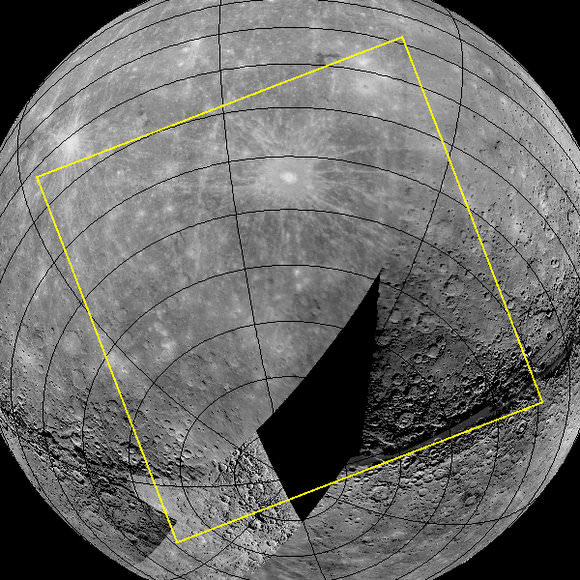[/caption]
When MESSENGER streaked into the early morning sky over Cape Canaveral on Aug. 3, 2004, very little was known about Mercury.
That could soon change. This week, MESSENGER — which stands for MErcury Surface, Space ENvironment, GEochemistry and Ranging — will make history when it becomes the first spacecraft to orbit Mercury.
At 8:45 p.m. EDT on Thursday, MESSENGER will execute a 15-minute maneuver that will place it into orbit around Mercury, kicking off a year-long science campaign to understand the innermost planet. The craft will fly around Mercury 730 times in the first year, and may be extended for another year after that.
No spacecraft had approached Mercury since the Mariner 10 space probe performed three fly-by maneuvers over the course of 1974 and 1975, imaging the planet’s surface. However, Mariner 10 sent back photos of only one side of the planet, leaving the other shrouded in mystery.
The MESSENGER mission — led by NASA, the Applied Physics Laboratory at Johns Hopkins University and the Carnegie Institution — is an effort to study the geologic history, magnetic field, surface composition and other mysteries of the planet. The findings are expected to broaden our understanding of rocky planets, more and more of which are being discovered in other solar systems. One of the most compelling enigmas surrounds Mercury’s magnetic field. At a diameter only slightly larger than that of the moon (about 4,800 kilometers or 2,983 miles), Mercury should have solidified to the core. However, the presence of a magnetic field suggests the planet’s insides are partially molten.
During its journey toward Mercury, MESSENGER passed the planet several times, filling in the imaging gaps left by Mariner 10. Now, the entire planet with the exception of about five percent has been observed. MESSENGER will focus its cameras on getting the best possible images of the remaining portions, mostly in the polar regions.
The in-flight preparations for this historic injection maneuver began on Feb. 8, when several heaters on the spacecraft were configured to condition the bi-propellant used during the maneuver. Starting on March 8, antennas from each of the three Deep Space Network (DSN) ground stations began a round-the-clock vigil, allowing flight control engineers at the Johns Hopkins University Applied Physics Laboratory (APL) in Laurel, Md., to monitor MESSENGER on its final approach to Mercury. Also that day, the spacecraft began executing the last cruise command sequence of the mission. The command load executed until today. Now, the command sequence containing the orbit-insertion burn has begun.
APL is hosting a live webcast about the orbit insertion maneuver starting at 7:55 p.m. EDT on Thursday, March 17.
For those of you living near Johns Hopkins, APL and The Planetary Society will co-host a public lecture in APL’s Kossiakoff Center, featuring MESSENGER Project Scientist Ralph L. McNutt, Jr. The lecture will begin at 8 p.m. on Thursday. RSVP online.
Check Universe Today late on Thursday for coverage of the orbit insertion, with input from related talks at the Laboratory for Space Physics (LASP) in Boulder, Colorado. Meanwhile, for more information, check out NASA’s MESSENGER mission website.
Sources: NASA’s MESSENGER mission website and a press release from the University of Arizona.


“MESSENGER will focus its cameras on getting the best possible images of the remaining portions, mostly in the polar regions”
I’ll be most interested in what MESSENGER reveals in the polar regions of Mercury, seeing as evidence (radar studies in the 1990s) strongly suggests *water ice* may lay hidden in deep craters that never see sunlight: http://nssdc.gsfc.nasa.gov/planetary/ice/ice_mercury.html
From Wiki: htp://en.wikipedia.org/wiki/Mercury_%28planet%29#Surface_conditions_and_.22atmosphere.22_.28exosphere.29
“.. Mercury should have solidified to the core. However, the presence of a magnetic field suggests the planet’s insides are partially molten.”
Is that really what is suggests?
Well, no. If there are field lines wrapped round the body, it may be an induced response to the solar wind IIRC, especially if there are some kind of atmosphere to ionize.
So let us assume they have recognized an internal field. If it is bipolar, it is likely a dynamo field since a frozen field would easily fragment (Mars). So let us assume this is the type of field they have found.
[Our Moon also have a liquid core, observed by Apollo seismic equipment. Its field is however not (all) bipolar but mostly look like a field from a frozen first diapir AFAIK, convectional bubble of a once viscous mantle after differentiation. I have a rather good reference somewhere.
Maybe a still liquid core and a frozen diapir is consistent, in which case the Moon may have characteristics of both types of fields. I haven’t seen such an analysis though (layman here).]
Mmmm… this is gonna be good!
May the MDIS, the GRNS, the MAG, the MLA, the MASCS, the EPPS, and the RS experiments work flawlessly! HO!
what is 19:55 EST in GMT?, hope it isnt too late
23:55 March 17. This is from http://www.timeanddate.com/worldclock/converted.html?day=17&month=3&year=2011&hour=19&min=55&sec=0&p1=179&p2=0
Eastern Daylight Time already.
Apparently E.D.T. started last Sunday 13 March. Here in UK, Daylight Saving starts Sunday 27 March. Timezones eh?!!
9:10 burn complete with fuel (lotsa) to spare! Can’t wait for the science to stream in…yea!
That was E.D.T.